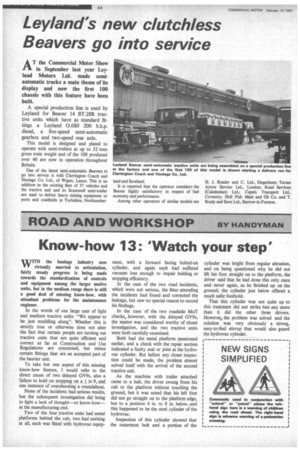Know-how 13: 'Watch your step'
Page 46

If you've noticed an error in this article please click here to report it so we can fix it.
WITH the haulage industry now virtually married to articulation, fairly steady progress is being made towards the standardization of controls and equipment among the larger motive units, but in the medium range there is still a good deal of missing know-how, with attendant problems for the maintenance engineer.
In the words of one large user of light and medium tractive units: "We appear to be just muddling along". Whether this is strictly true or otherwise does not alter the fact that certain people are turning out tractive units that are quite efficient and correct as far as Construction and Use Regulations are concerned, but minus certain fittings that are an accepted part of the heavier unit.
To take but one aspect of this missing know-how feature, I would refer to the direct cause of two delayed GV9s, also a failure to hold on stopping on a! in 9, and one instance of overshooting a roundabout.
None of the incidents had serious results, but the subsequent investigation did bring to light a lack of thought—or know-how— at the manufacturing end.
Two of the four tractive units had metal platforms behind the cab, two had nothing at all, each was fitted with hydrovac equip
ment, with a forward facing bolted-on cylinder, and again each had suffered vacuum loss enough to impair holding or stopping efficiency.
In the case of the two road incidents, which were not serious, the fitter attending the incidents had found and corrected the leakage, but saw no special reason to record his findings.
In the case of the two roadside MoT checks, however, with the delayed GV9s, the matter was considered worthy of closer investigation, and the two tractive units were both carefully examined.
Both had the metal platform mentioned earlier, and a check with the repair section indicated a faulty seal or joint at the hydrovac cylinder. But before any closer inspection could be made, the problem almost solved itself with the arrival of the second tractive unit.
As the machine with trailer attached came to a halt, the driver swung from his cab to the platform without touching the ground, but it was noted that his left foot did not go straight on to the platform edge, but to a position 6 in. to 8 in. below, and this happened to be the steel cylinder of the hydrovac.
Inspection of this cylinder showed that the outermost bolt and a portion of the cylinder was bright from regular abrasion, and on being questioned why he did not lift his foot straight on to the platform, the driver said that he had done this only once and never again, as he finished up on the ground; the cylinder just below offered a much safer foothold.
That this cylinder was not quite up to this treatment did not strike him any more than it did the other three drivers. However, the problem was solved and the solution was very obviously a strong, easy-to-find stirrup that would also guard the hydrovac cylinder.












































































































